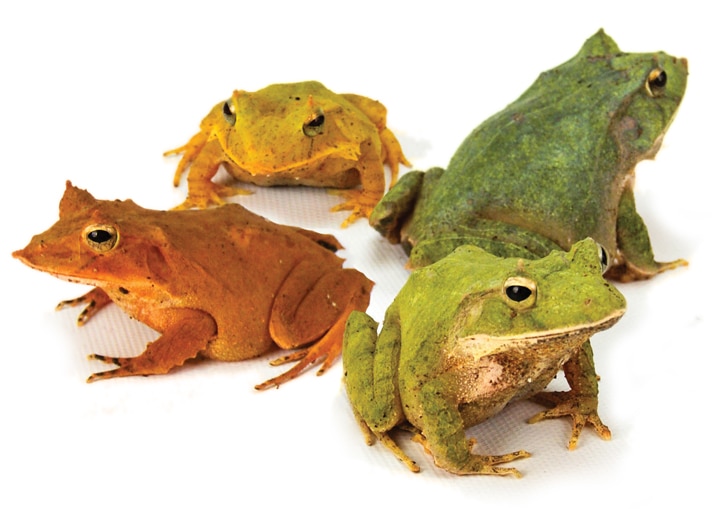This species of frog is now widely available as healthy, captive-bred specimens.
Whether you are experiencing frogs for the first time or have had a lifetime of experience working with these awe-inspiring creatures, it is safe to say that we are all on the same page when it comes to our fascination with them.
Looking to add a really unique animal to your menagerie? Are you fascinated by the unusual? Then consider the Solomon Island leaf frog, known scientifically as Ceratobatrachus guentheri. These leaf litter mimics are ambush predators that come in almost all the colors of the rainbow! Once considered difficult captives, this species is now widely available as healthy, captive bred specimens. If this awesome anuran piques your interest, now is the time to jump!

zach brinks
Captive-bred Solomon Island leaf frogs are better suited to a life in captivity and do not have any negative impact on already struggling wild populations.
Solomon Island Leaf Frog Natural History
Solomon Island leaf frogs (often abbreviated SILFs) are also known as Solomon Island eyelash frogs or Guenther’s triangle frogs. As the name might suggest, these frogs are native to the Solomon Islands, where they live in and among leaf litter on the forest floor. Interestingly enough, this frog seems to be very adaptable to human disturbance and can even be found in gardens bordering their native habitat. First described in 1884, this odd frog is also the only member of its genus.
Unlike many amphibian species worldwide, this frog is doing relatively well in the wild. Collection for the pet trade is a minor threat—habitat loss poses a much higher risk. According to the IUCN Red List (which monitors animal conservation statuses across the globe), this is a species of Least Concern—it is not in immediate danger of disappearing.
Solomon Island Leaf Frog Enclosure Tips
Housing these frogs is a fairly simple affair but does depend greatly on the size of the frog. I’ll outline enclosure guidelines for 3-4 month old juveniles (the age SILFs are typically sold) and adult animals here. Here you will find suggested reptile supplies, husbandry advice, and enrichment tips for amphibian health and wellness.
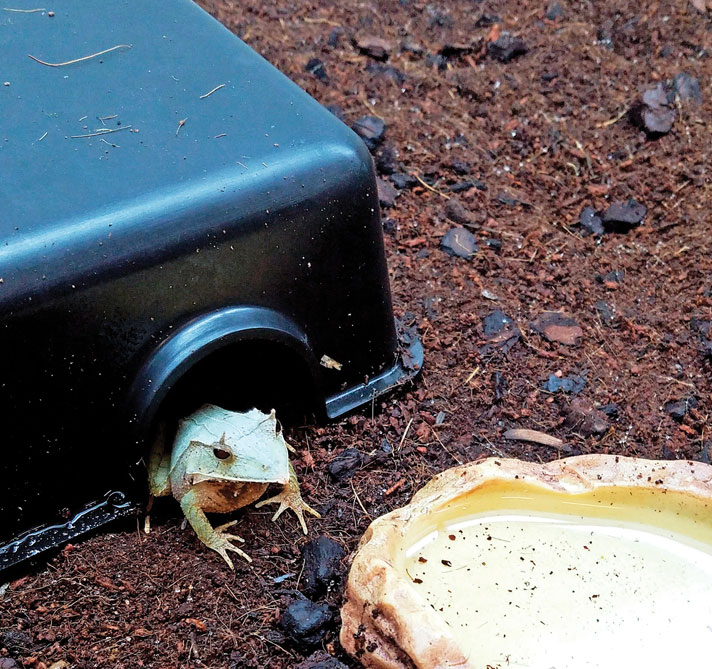
zach brinks
Provide a hide for your frog to ensure good health.
Juveniles do not require a ton of space compared to adults but still appreciate a fairly roomy enclosure. At 3-4 months old, the young frogs are typically about 1 inch long and will do well for the next few months in a 10-20 Liter reptile terrarium. A screen top partially covered with plastic or glass to help maintain a humidity level of about 60 percent is a requirement. Amphibian substrate should be about 2 inches deep and consist of a coco fiber mix, like Exo Terra Coco Husk, that drains well. We also use and recommend Josh’s Frogs Solomon Island Leaf Frog substrate, which is a concoction we created after several years of trial and error. It’s important that the substrate drains well, does not contain any sharp particulates that could injure a SILF’s thin skin, and is inexpensive, as you’ll want to change the substrate monthly. You can use an amphibian hygrometer to monitor your humidity conditions.
Frog habitat products are best kept simple, as the focus of this setup should be monitoring your young frog’s growth and eating habits. A thin layer of leaf litter will provide plenty of hiding areas and visual barriers if you’re raising a group of Solomon Island leaf frogs together in the same enclosure. I’d recommend against branches or anything that provides vertical height, as SILFs are exclusively terrestrial amphibians. Instead, provide a few curved pieces of cork or reptile caves, so your frogs can be under cover without rubbing their back on a rough surface; this is a common problem with frog supplies and often results in a frog losing it’s trademark eyelashes.
A shallow water bowl is useful if you are unable to mist at least twice a day. Make sure it is very shallow and easy for your frog to enter and leave. SILFs are notoriously bad swimmers and drown easily. A handful of long fiber sphagnum moss kept constantly damp is an easy way to provide a humid retreat for your frogs. Young SILFs dry out surprisingly quickly, and that humid retreat is a great insurance policy against an unexpected dip in ambient humidity.
Setup for adults is similar as juveniles, just on a large scale. An enclosure with at least a 36-inch by 18-inch footprint should be considered mandatory for one to five adults, with a larger enclosure being even more desirable. Stick to the same substrate, just at a depth of at least 4 inches. Leaf litter is not mandatory but definitely is appreciated. This will provide more places for feeder insects to hide, so make sure your frogs are getting enough to eat if you do decide to provide dried leaves. A shallow water bowl coupled with several hides will round out the setup.
Going Bioactive
Solomon Island leaf frogs are very particular about cleanliness; old lines (aka many of the ‘high yellow’ Solomon Island leaf frogs available from some breeders) are particularly sensitive to high bacterial loads in their environment. Because of this and the need to easily search for egg clutches every month, we opted to avoid the bioactive route for this species at Josh’s Frogs. It can, however, be done at home—it just requires some planning and a bit of space!
You know these frogs already appreciate a larger enclosure, but if you’re going bioactive, plan on providing even more room! A 40B tank (36-inch by 18-inch footprint) set up bioactively is suitable for two to three Solomon Island leaf frogs, as long as it is cycled. DO NOT put SILFs in a newly set up bioactive tank—they’ll often fail to thrive in a couple weeks. After the tank is a month or more along, they’ll thrive.
BioBedding Tropical, available at Josh’s Frogs, makes a great base bioactive substrate for a SILF vivarium. Paired with springtails and isopods, both of which thrive in this substrate, it’ll make short work of any waste and grows plants like a charm. A 3-4-inch deep layer will provide space for your frogs to dig down and plenty of room for roots to take hold. Hardy, easy-to-care-for plants, such as pothos and philodendron, make great choices. A layer of larger sized leaf litter (magnolia or sea grape fit the bill) will top off the setup and provide places to hide.
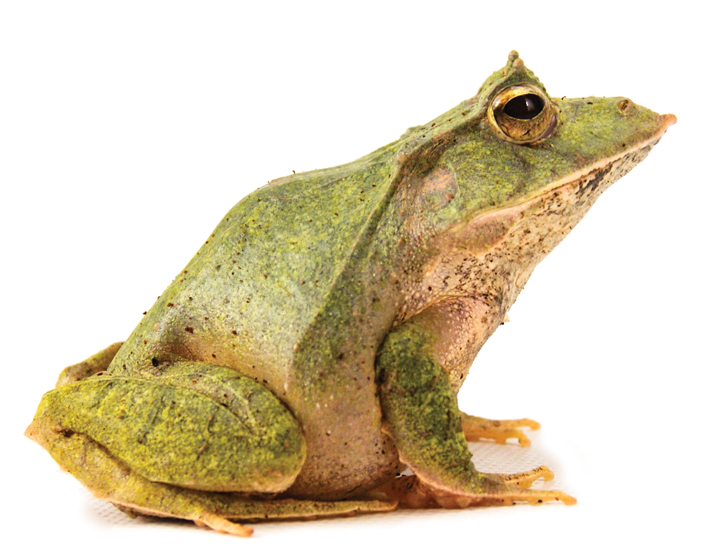
zach brinks
These voracious frogs are fun to feed and can learn to take food from tongs with practice.
Lighting at any age is simple; a low level UVB source, such as an Exo Terra 5.0 fluorescent lamp, will aid in calcium absorption and provide light to observe your frogs by. Keep the light on a 12 on/12 off cycle. Solomon Island leaf frogs are nocturnal and will spend most of their time during the day hunkered down in cover or partially buried in the substrate. Often, the tank will seem empty until, on closer inspection, a pair of fleshy horns (the “eyelashes” above the eyes) are spotted sticking out of the substrate.
Frogs will become active in the evening, with males often uttering a loud, honking call to entice females. As the evening progresses and night settles in, the leaf frogs will find spots to settle down and wait for prey to wander by.
Mist often enough to maintain a humidity of 60 percent or so but not so much that the enclosure becomes drenched. I recommend misting at lights on and lights off if possible, but a heavy misting once a day will suffice. At Josh’s Frogs, we use reverse osmosis water, but distilled water (or even dechlorinated tap water with a low mineral content) is fine. If you have hard water, I would recommend against using it with Solomon Island Leaf Frogs.
SILFs prefer a temperature in the mid to high 70° F but will tolerate 70-85° F. The recommended UVB light will raise ambient temperature a few degrees above room temperature, which should be sufficient in most cases. I recommend against utilizing basking spots, as the bulbs can quickly cause the enclosure to dry out. If supplemental heating is needed, I’d recommend using a heat pad, either on the bottom on back side of the enclosure.
Make sure to closely monitor both temperature and humidity with a digital gauge. The round analog ones cheaply sold at many pet stores should not be trusted—they’re notoriously unreliable, which can quickly lead to an uncontrolled climate and dead frogs. Spend a bit more and get a reliable, digital device, and check it regularly.
SILFs can be housed in groups, but keep in mind that females may be aggressive toward other females and sometimes other frogs when they’re not in the mood! We’ve had groups of four to six adults do well together for long periods of time, only to suddenly have a large female go on a murderous rampage and try to destroy any tank mates. In general, as long as any adult females are not significantly larger than other members of the group, they’ll probably be fine. If there’s a size difference, pull the larger animal. We house most of our SILFs in pairs or m/f/f trios.
Feeding Solomon Island Leaf Frogs
Solomon Island leaf frogs have quite the appetite and should be fed daily. Staple feeders should consist of crickets or dubia roaches. There are plenty of other feeder insects that can be utilized to vary up your frog’s diet—check out the sidebar “Fun Foods for your SILFs” for more options. As a general rule, offer three to four crickets (or the equivalent mass of other feeder insects) every day to your Solomon Island leaf frogs.
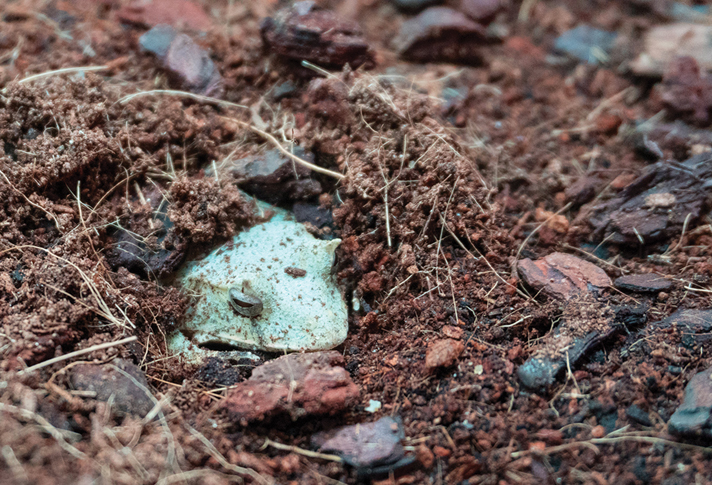
zach brinks
These unique frogs have such a colorful and atypical appearance, they really stand out, even to seasoned frog keepers.
There are two primary ways to feed your leaf frogs—by releasing insects into the habitat or by tong feeding. Simply dumping some crickets in to the habitat to let your frogs eat at their leisure is definitely easier but can make monitoring food intake difficult, especially if leaf litter is used. Tong feeding doesn’t take much time, allows you to offer a more diverse variety of prey items, know exactly how much food is being consumed, and is a lot of fun!
Regardless of what you choose to do, make sure to dust all feeder insects with a quality vitamin and mineral supplement. There are several brands on the market that are suitable. Repashy Calcium Plus is a good all-in-one supplement and works well for growing froglets and maintaining adults. For breeding adults, we also rotate in RepCal Calcium plus D3 and RepCal Herptivite. Feed all crickets and dubia roaches a quality gutload for 48 hours before offering to your pet.
Fun Foods For Your SILFS
These voracious frogs are fun to feed and can learn to take food from tongs with practice. This is great when showing off your amazing anurans to friends and family; a leaf will seemingly come alive and lunge at a prey item, only to swallow it and disappear into the environment. The following insects are great staple foods and treats for your Solomon Island leaf frogs. Don’t forget to dust prey items with a quality vitamin/mineral supplement!
Crickets – a longtime staple in the reptile and amphibian hobby, crickets can easily make up the bulk of your frog’s diet. At Josh’s Frogs, we prefer banded crickets; this species is quieter, easier to digest and moves around a lot more.
Dubia Roaches – when tong fed, dubia roaches can replace crickets as a staple SILF diet. They don’t move around like crickets, and loose dubia roaches will often be ignored.
Superworms – these are great as an occasional treat for SILFs. They may be eaten if dropped right in front of the frog but are best fed via tongs.
Nightcrawlers – Surprisingly nutritious, nightcrawlers are a great treat if your frog will take them. Offer them on tongs, but don’t be surprised if your frog ignores them—they’re an acquired taste!
Butterworms – relatively new on the feeder insect scene, butterworms are large, orange, tasty and best offered as an occasional treat via tongs.
Waxworms – high in fat, waxworms make a great treat for your SILF. Tong feed occasionally.
Selecting a Solomon Island Leaf Frog
Now that you know a bit about caring for Solomon Island leaf frogs, let’s discuss how to chose one! The first thing to realize is that, while wild-caught SILFs are less common, they sometimes are available and should be avoided at all costs. They typically come in a bit beat up, as it’s difficult to ensure eyelashes and rostral appendages remain intact when shipping adult animals. This often leads to a bald appearance on those individuals that do eventually acclimate to captivity—a feat that few wild-caught Solomon Island leaf frogs will accomplish. Typically, they waste away due to internal parasites (I have yet to examine an untreated wild-caught SILF that wasn’t full of worms), succumb to bacterial infection, or eventually die after bashing themselves silly on the walls of the enclosure.
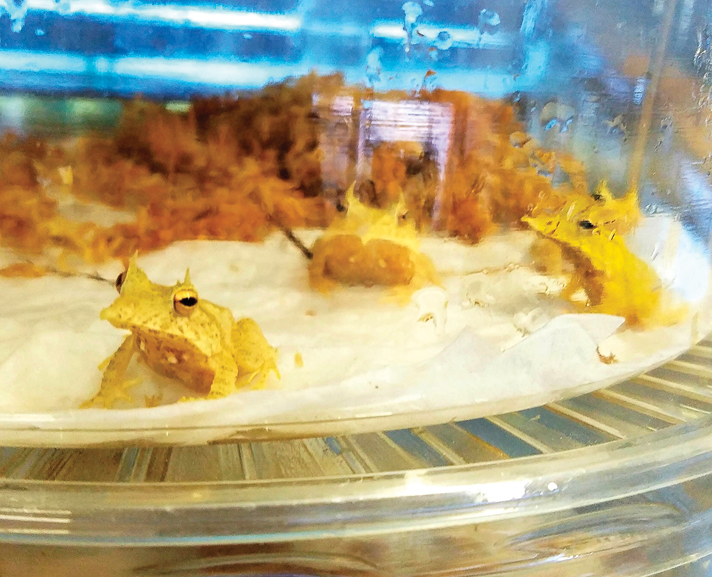
zach brinks
Solomon Island leaf frogs can be sexed at a young age.
Instead, buy captive-bred! Captive-bred animals are better suited to a life in captivity and do not have any negative impact on already struggling wild populations. They’re generally free of most common diseases (especially chytridiomycosis and ranavirus—any responsible amphibian dealer should test their stock, so ask!) and parasites and already used to captive conditions. They are also less stressed, handle the shipping/transport process better and settle into their new home much quicker.
You may be lucky enough to encounter them at your local reptile store, but they are still uncommon enough for this to be unlikely. You may have better luck at a reptile show. Most likely, you’ll need to turn to the internet. There, amphibian breeders, such as JoshsFrogs.com, and animal dealers will offer up hopefully captive-bred specimens. Once you find a supplier that appears reputable, make sure to confirm the captive-bred source. If the supplier did not produce the animal themselves, make sure they’ve had it for at least several weeks.
Frogs should be from stock that has tested negative for chytridiomycosis and ranavirus, at least 3 months old and over ¾ inches in length. If you see the animals in person before purchase, ensure that the sharp nose point and horns above the eyes are intact. Eyes should be clear, and the SILF should have a pudgy appearance. Frogs should not appear round—this can be a sign of bacterial infection and fluid retention, a common problem if the amphibians are housed in unsanitary conditions.
Solomon Island leaf frogs should spend most of their time sitting with all four feet on the substrate and their head held upright. When they move, it should be in short hops. If a leaf frog does not receive proper nutrition at a young age, it can develop rubbery limbs, which leads to stumbling and occasionally flipping over. This condition is typically not reversible and afflicted frogs should be avoided at all costs.
One of the most remarkable features of Solomon Island leaf frogs is the wide palette they naturally occur in. All offspring will generally start out life a tan, brown or yellow color. This juvenile coloration is not a good indicator of the frog’s adult appearance—changes are a coming!
Sexing Solomon Island Leaf Frogs
These frogs are unique in more ways than just their appearance! A quality a fellow hobbyist of mine, Jason Juchems, pointed out years ago that these frogs can be visually sexed at a pretty young age of just a few months. This technique isn’t foolproof, but it can be pretty accurate when used by a skilled SILF breeder and is really helpful when selecting offspring to hold back for future breeders.
If you carefully turn this frog onto its back, you can carefully examine its translucent underside for evidence of two faint white lines running down the back half of center. These are the frog’s ureters and are only present in male Solomon Island Leaf Frogs. Using a jeweler’s loop, they may be visible at a few months of age but can be very obvious in adult frogs. Accuracy greatly increases the older the frog is. I used this strategy a few years ago at an importer’s in Miami to pick out a large group of 30 individuals to add some genetic diversity to the breeding groups at Josh’s Frogs, and it proved accurate on 28 individuals.
Males make a loud honking call, but females can emit noises too, making sexing difficult. Mature females in breeding condition will often have eggs visible through their underside.
Breeding Solomon Island Leaf Frogs
As long as your SILFs are over 3 inches and 8 months old, they are pretty simple to breed. It’s common for these frogs to be female heavy—we’ve raised up 10 frogs before, only to end up with one male! Assuming both sexes are present, a male will call in the evening to attract a female. If he’s successful, his chosen mate will bury a clutch of 10-60 pea-sized eggs 1-2 inches deep in the substrate. Older females will produce larger clutches.
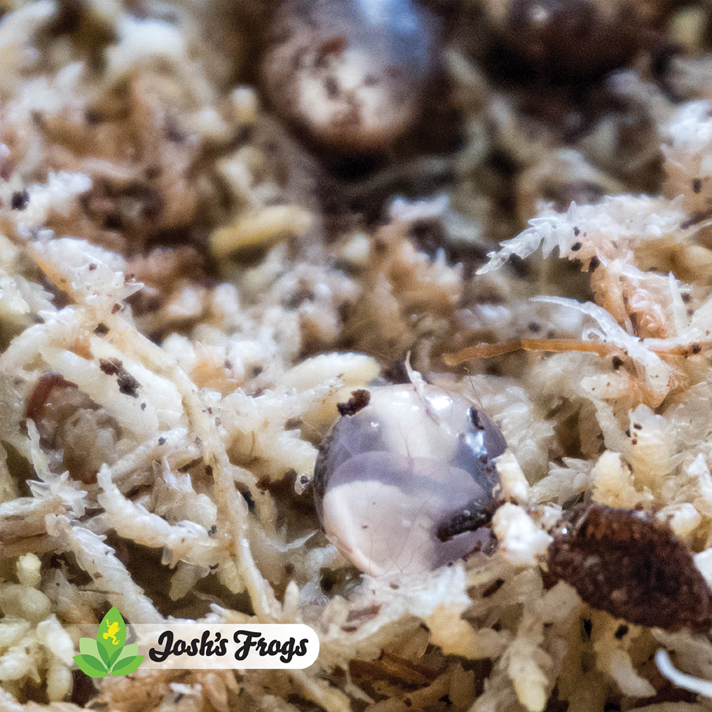
zach brinks
Solomon Island leaf frogs go through the tadpole stage in the egg, and after 6-8 weeks, a miniature frog will hatch out.
Eggs can be left to hatch in the enclosure, but adults will prey on froglets, trample egg clutches or otherwise lower the hatch rate. We pull clutches every month at Josh’s Frogs for incubation in a deli container. Eggs are placed on a bed of moist sphagnum moss. Any eggs that develop mold are quickly disposed of; fungus can spread and take out an entire clutch if not dealt with quickly. If you do lose some eggs, don’t fret—SILFs can be pretty prolific, and you’ll have plenty of opportunities to successfully rear your own generation of Solomon Island leaf Frogs.
As the clear eggs develop, you’ll notice a trait that makes SILFs stand out from most other frogs—they go through the tadpole stage in the egg, and after 6-8 weeks, a miniature frog will hatch out—a process called direct development.
After your new SILFs have hatched, leave them in the incubating container for at least 24-48 hours. The young will initially have a round appearance, much like the egg they emerged from. Over the first two days, it’ll take on a more frog-like appearance and begin to move around. Now is the time to introduce it into the rearing container. We use 10-inch deli cups with a moist paper towel substrate (changed twice a week) and a handful of damp sphagnum for a hide. Initially offer pinhead crickets or wingless melanogaster fruit flies, then proceed to 1/8-inch crickets after a couple weeks. Within two months, the frogs should be able to eat ¼-inch crickets. Don’t forget to dust all prey items.
Conclusion
Smitten by Solomon Island leaf frogs? So am I! These unique creatures have such a colorful and atypical appearance, they really stand out—even to seasoned frog keepers. Fortunately, they’re slowly but surely becoming more and more available as healthy, captive bred froglets, largely due to the efforts of small hobbyists and a few dedicated professional breeders. Given the proper care, Solomon Island leaf frogs make easy and rewarding captives.
Zach Brinks oversees the animal breeding operations at Josh’s Frogs, the largest pet amphibian breeding operation in the world.

